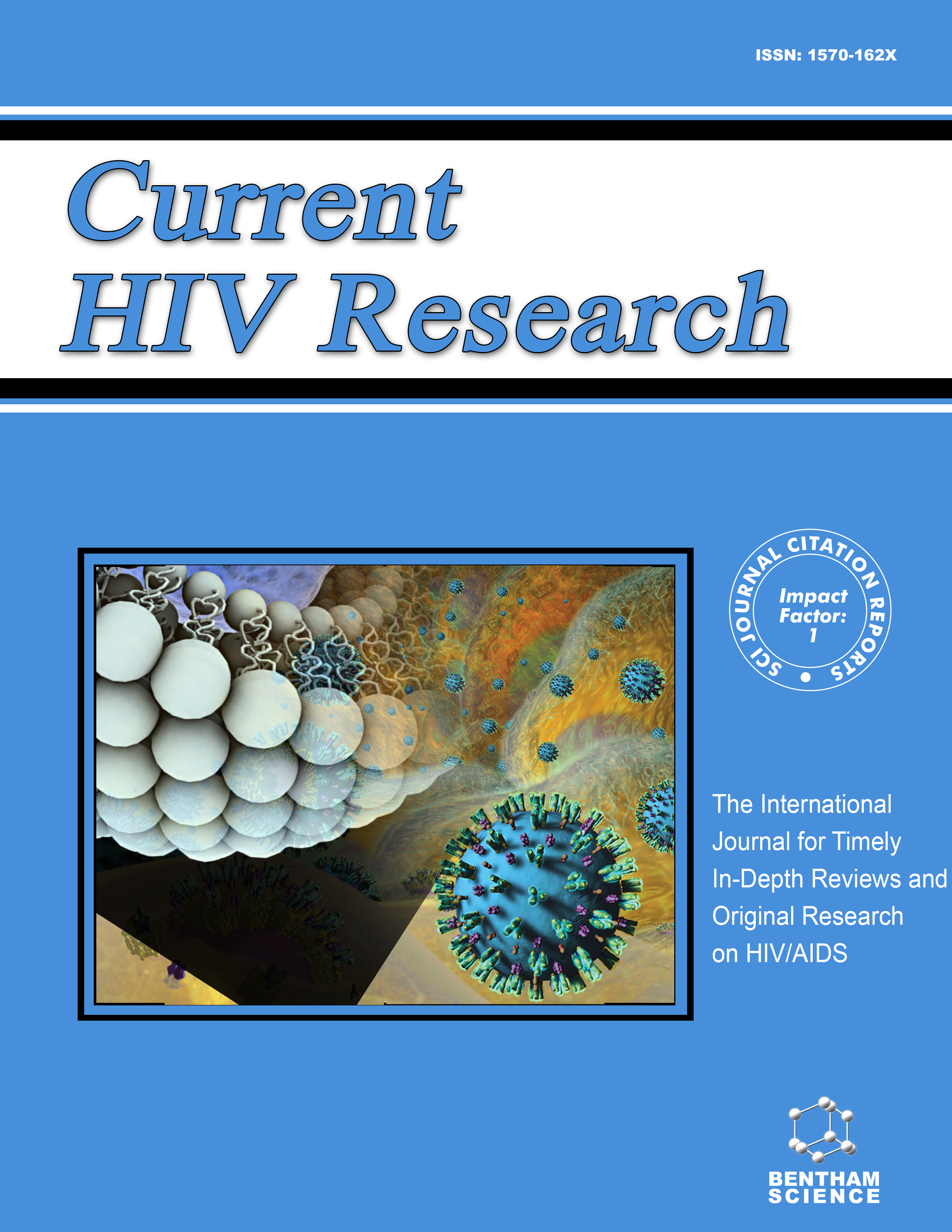- Home
- A-Z Publications
- Current HIV Research
- Previous Issues
- Volume 9, Issue 2, 2011
Current HIV Research - Volume 9, Issue 2, 2011
Volume 9, Issue 2, 2011
-
-
Anal Cancer: Focus on HIV-Positive Patients in the HAART Era
More LessAnal cancer represents an increasing health problem, especially in immune-compromised patients, as HIVpositive patients. Notably, a significant higher incidence rate is reported among HIV infected patients with the advent of highly active antiretroviral therapy (HAART). To date, no randomised trial supports the correlation between existing screening strategies and reduced progression of anal intraepithelial neoplasi Read More
-
-
-
Impact of the Frequency of Plasma HIV-1 RNA Monitoring on the Outcome of Antiretroviral Therapy
More LessBackground: Current guidelines for HIV management recommend monitoring plasma HIV-1 RNA level every 3-6 months in patients on a stable antiretroviral regimen. However, cost is the major obstacle to follow the guidelines in resource-limited settings. Objective: This study aimed to compare the outcome of antiretroviral therapy among HIV-infected patients on a stable regimen who had plasma HIV-1 RNA monitoring Read More
-
-
-
Antiretroviral Treatment of HIV Infection Does Not Influence HIVSpecific Immunity but Has an Impact on Non-Specific Immune Activation
More LessAuthors: Zofia Bartovska, Ondrej Beran, Hanus Rozsypal and Michal HolubHIV-specific and non-specific immune responses are crucial in the immunopathogenesis of HIV infection. Therefore, the objective of our study was to analyze the frequency and functional status of HIV-specific CD8+ T cells and the expression of non-specific activation markers on CD8+ T cells in HIV+ patients, and to assess the effects of combined antiretroviral treatment (cART). We examined 28 HIV+ patients, including 13 patie Read More
-
-
-
In Vitro Anti-HIV-1 Activity of the Aqueous Extract of Asterina Pectinifera
More LessAuthors: Fatih Karadeniz, Mustafa Zafer Karagozlu, Chang-Suk Kong and Se-Kwon KimAn aqueous extract of starfish, Asterina pectinifera, was investigated for its anti-HIV-1 efficiency in vitro on human T-cell lines. A. pectinifera significantly maintained the viability of HIV-infected cells as much as 86% of the untreated infected control cells at the non-toxic concentrations (0.05∼4 mg/mL) in CEM-SS cells. Anti-HIV-1 activity of A. pectinifera extract was further supported by quantification of syncytia formatio Read More
-
-
-
Factors Associated with HIV Virologic Failure Among Patients on HAART for One Year at Three Sentinel Surveillance Sites in China
More LessAuthors: Xia Wang, Liting Yang, Huiqin Li, La Zuo, Shujia Liang, Wei Liu, Yonghui Dong, Shaomin Yang, Hong Shang, Jingyun Li, Laiyi Kang, Ping Zhong, Wei Zheng, Lingjie Liao, Hui Xing, Ray Y. Chen, Yuhua Ruan and Yiming ShaoBackground: Emerging HIV drug resistance (HIVDR) poses a growing threat to the long-term success and durability of highly active antiretroviral therapy (HAART). Objective: To understand the development of HIVDR and estimate the proportion of potential HIVDR and its associated risk factors among the patients on HAART for one year. Methods: Antiretroviral-naive patients ≥18 years old were invited to participate in this one-y Read More
-
-
-
Association Between Polymorphism of SDF1 (CXCL12) Gene and HIV-1 Susceptibility: A Meta-Analysis
More LessAuthors: SiJie Liu and HuanZhang ZhuStudies on the association between SDF1 genotype and HIV-1 susceptibility have generated inconclusive results. Therefore, we conducted a meta-analysis to summarize the findings of different studies. Articles reporting SDF1 gene polymorphisms among HIV-1 infected patients and controls were searched from PubMed up to June 2010. Odds ratios (ORs) with 95% confidence intervals (CIs) were applied to assess the associati Read More
-
-
-
HIV-Infected Patients and Liver Transplantation: Who, When and Why
More LessWell into the 25th year of the HIV pandemics, and into the 15th year of the highly active antiretroviral therapy (HAART) era, liver transplantation (LT) in the HIV population might be viewed as both a problem and an opportunity. It is still a problem when we consider that only a small proportion of all HIV-infected patients with end stage liver disease (ESLD) will have access to this precious and limited resource. But, in the face of t Read More
-
-
-
Non-Alcoholic Fatty Liver Disease in HIV Infection Associated with Altered Hepatic Fatty Acid Composition
More LessHepatic fatty acid (FA) composition, especially a reduction in n-3 polyunsaturated FA (PUFA) may contribute to the pathogenesis of non-alcoholic fatty liver disease (NAFLD), which is common in HIV-infection. In a cross-sectional study we compared hepatic FA composition between 20 HIV-infected men with NAFLD (HIV/NAFLD), 21 HIVnegative men with NAFLD (NAFLD), and 7 healthy controls. Within HIV/NAFLD we compare Read More
-
-
-
The Dynamic Face of HIV-1 Subtypes Among Men who have Sex with Men in Beijing, China
More LessAuthors: Wanhai Wang, Jianqing Xu, Shulin Jiang, Kai Yang, Zhefeng Meng, Yan Ma, Mingkui Li, Xiaoxi Zhang, Yiming Shao, Fengmin Zhang and Xiaoyan ZhangThe rapid increase of HIV-1 prevalence among Chinese men who have sex with men (MSM) provides an impetus for the acquisition of molecular epidemiologic information from this population. We conducted four serial crosssectional surveys during the years 2005-2009 and observed that the composition of HIV-1 subtypes was dynamically changing from clade B to CRF01_AE from years 2005-2009. HIV-1 infection in this popula Read More
-
Volumes & issues
-
Volume 23 (2025)
-
Volume 22 (2024)
-
Volume 21 (2023)
-
Volume 20 (2022)
-
Volume 19 (2021)
-
Volume 18 (2020)
-
Volume 17 (2019)
-
Volume 16 (2018)
-
Volume 15 (2017)
-
Volume 14 (2016)
-
Volume 13 (2015)
-
Volume 12 (2014)
-
Volume 11 (2013)
-
Volume 10 (2012)
-
Volume 9 (2011)
-
Volume 8 (2010)
-
Volume 7 (2009)
-
Volume 6 (2008)
-
Volume 5 (2007)
-
Volume 4 (2006)
-
Volume 3 (2005)
-
Volume 2 (2004)
-
Volume 1 (2003)
Most Read This Month
Article
content/journals/chr
Journal
10
5
false
en


